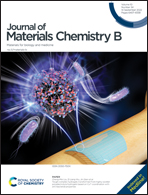Hypoxia inducible factor-1 signaling pathway in macrophage involved angiogenesis in materials-instructed osteo-induction†
Abstract
Although osteo-inductive materials are regarded as promising candidates for critical-sized bone repair, their clinical application is limited by ambiguous mechanisms. The hypoxia-inducible factor (HIF)-1 signaling pathway, which responds to hypoxic conditions, is involved in both angiogenesis and osteogenesis. Strategies harnessing HIF-1 signaling to promote angiogenesis have been applied and have succeeded in repairing segmental bone defects. Meanwhile, macrophages have been shown to have important immunoregulatory effects on material-induced osteo-induction and correlate with HIF-1 activity. Thus, it is reasonable to assume that HIF-activated macrophages may also play important roles in the angiogenesis of material-induced osteo-induction. To verify this assumption, a classical type of osteo-inductive calcium phosphate (TCPs) was utilized. First, using RNA sequencing, we found that hypoxia activated the HIF signaling pathway in macrophages, which contributed to angiogenesis in TCPs. In addition, after treatment with a conditioned medium extracted from the co-culture system of macrophages and TCPs under hypoxic conditions, the migration and tube formation ability of human umbilical vein endothelial cells (HUVECs) significantly increased. In vivo, inhibition of HIF-1 or clearance of macrophages could result in impaired angiogenesis in TCPs. Finally, more blood vessels were formed in the TCPs group than in the control group. In conclusion, this study elucidated the vital role of the HIF signaling pathway in infiltrating macrophages during early vessel growth in material-induced osteo-induction. It is beneficial in advancing the exploration of the related mechanism and providing possible support for optimizing the applicability of osteo-inductive materials in bone repair.



 Please wait while we load your content...
Please wait while we load your content...